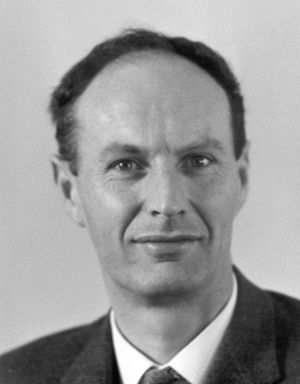John Frank Adams
1930-1989. Mathematician;  Fellow and Lowndean Professor of Astronomy and Geometry. One of the founders of homotopy theory; a keen mountaineer.
Fellow and Lowndean Professor of Astronomy and Geometry. One of the founders of homotopy theory; a keen mountaineer.
Frank Adams was educated at Bedford School and then spent the years 1948 and 1949 doing national service in the Royal Engineers. At Trinity he was a wrangler in part two and gained special credit in part three of the mathematical tripos. He continued at Cambridge as a research student, first under Abram Besicovitch and then, more significantly, under Shaun Wylie. His PhD dissertation (1955) was on algebraic topology, which remained his main research interest for the rest of his life. Adams spent the year 1954 at Oxford, as a junior lecturer, where he came under the influence of J.H.C. Whitehead, then the leading topologist in the country.
Adams returned to Cambridge in 1956 as a research fellow at Trinity and developed the spectral sequence which bears his name, linking the cohomology of a topological space to its stable homotopy groups. In 1957-8 he was a Commonwealth fellow at the University of Chicago, where he proved a famous conjecture about the existence of H-structures on spheres, using the same ideas. On his return from the United States he became fellow, lecturer, and director of studies at Trinity Hall, where he confirmed his already high international reputation by solving another famous problem, concerning vector fields on spheres. For this he invented some operations in K-theory, which later bore his name, and these proved to be of fundamental importance.
In 1962 Adams left Cambridge for Manchester University, where in 1964 he became Fielden professor and was elected FRS at the early age of thirty-four. At Manchester he took much further the powerful methods he had originated at Cambridge in a celebrated series of papers ‘On the groups J(X)’, which opened up a new era in homotopy theory. In the first of these he made a bold conjecture about the relation between the classification of vector bundles by stable isomorphism and their classification by stable homotopy equivalence of the associated sphere-bundles. Reformulated in various ways this Adams conjecture (later a theorem) became one of the key results in homotopy theory.
By 1970 Adams was the undisputed leader in his field and his reputation was such that he was seen as the obvious person to succeed Sir William Hodge as Lowndean Professor of astronomy and geometry at Cambridge. He was delighted to return to Trinity, though he never became very active in its affairs. Among his various research interests in this later phase of his career three subjects predominated: finite H-spaces, equivariant homotopy theory, and the homotopy properties of classifying spaces of topological groups. Although he published important papers on these and other subjects throughout this period he also began to publish more expository work, notably his lecture notes on Stable Homotopy and Generalised Homology (1974) and his monograph, Infinite Loop Spaces (1978), based on the Hermann Weyl lectures he gave at Princeton University. The latter, especially, gives a good idea of his magisterial expository style and particular brand of humour.
Adams was an awe-inspiring teacher who expected a great deal of his research students and whose criticism of work which did not impress him could be withering. For those who were stimulated rather than intimidated by this treatment, he was generous with his help. The competitive instinct in Adams was highly developed, for example in his attitude to research. Priority of discovery mattered a great deal to him and he was known to argue such questions not just as to the day but as to the time of day. In a subject where ‘show and tell’ is customary he was extraordinarily secretive about research in progress.
Adams's great contributions to mathematics were recognized by the awards of the junior Berwick (1963) and senior Whitehead (1974) prizes of the London Mathematical Society and the Sylvester medal (1982) of the Royal Society. He received the degree of ScD from Cambridge in 1982. He was elected a foreign associate of the National Academy of Sciences of Washington, DC (1985), and an honorary member of the Royal Danish Academy of Sciences (1988), and was made an honorary ScD at the University of Heidelberg in 1986. His collected works were published in 1992. He acted as treasurer of the local branch of the Labour Party and might be described as an intellectual Fabian in outlook. Adams died immediately following a night-time accident in the car he was driving on the A1 near Brampton, Huntingdonshire, on 7 January 1989.
DNB
| Memorial inscription | Translation |
|
JOHN FRANK ADAMS HVIVS COLLEGII DISCIPVLVS ET PER XXII ANNOS SOCIVS
|
John Frank Adams was an undergraduate and then for twenty-two years a Fellow of the College. He was devoted to the truth and to justice. With equal zeal and perseverance he delighted in overcoming the challenges of rock-climbing and in untangling difficult problems in topology. He died in 1989 at the age of fifty-eight. |
John Frank AdamsBrass located on the north wall of the Ante-Chapel. |
Click on the thumbnail for a larger image. |
|
|
PREVIOUS BRASS |
|
NEXT BRASS |
| Brasses A-B | Brasses C-G | Brasses H-K | Brasses L-P | Brasses R-S | Brasses T-W |

